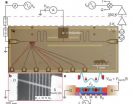(Press-News.org) ANAHEIM, Calif. — Twenty-nine percent of patients with colorectal cancer in a nationally representative sample were diagnosed after an emergency, such as an obstruction or perforation of the bowel, according to data presented at the 11th Annual AACR International Conference on Frontiers in Cancer Prevention Research, held here Oct. 16-19, 2012. In addition, African-Americans and those living in high-poverty areas were more likely to present with an emergency diagnosis.
"Overall, there are high rates of emergency presentation of colorectal cancer in the United States," said Sandi L. Pruitt, Ph.D., M.P.H., assistant professor in the department of clinical sciences at The University of Texas Southwestern Medical Center in Dallas. "Screening for colorectal cancer using tests including colonoscopy is recommended for all healthy, asymptomatic adults starting at age 50. But these high rates of emergencies indicate that there are multiple missed opportunities for screening. As a result, many patients are not diagnosed until they have an emergency, such as an obstruction or perforation of the bowel, which leads to more complications and a higher risk for death from cancer."
Pruitt and colleagues evaluated disparities in emergency colorectal cancer presentation using nationally representative Surveillance Epidemiology and End Results–Medicare data from 1992 to 2005 of U.S. adults aged 66 and older with invasive colorectal cancer.
They identified 88,859 patients with colorectal cancer, and of those, 29 percent presented as emergencies. Of these, 81.3 percent had an emergency admission, 31.6 percent were obstructions and 4.2 percent were perforations. In unadjusted analyses, African-American patients with colorectal cancer were 64 percent more likely to present as emergency cases, and those patients with colorectal cancer living in census tracts with the highest poverty rate (greater than or equal 20 percent versus less than 10 percent poverty) were 31 percent more likely to present as emergencies.
After researchers statistically controlled for multiple factors including cancer stage, patient health status and sociodemographic factors, African-Americans were 29 percent more likely to present with emergency cases, and those living in census tracts with the highest poverty rate were 10 percent more likely to present with emergency colorectal cancer.
"We already know that African-Americans and economically disadvantaged populations face an increased risk for death from colorectal cancer," Pruitt said. "In future research, we will attempt to understand how emergency presentation of colorectal cancer contributes to racial and economic disparities in death from colorectal cancer."
### Funding sources for this study include the Cancer Prevention Research Institute of Texas, the National Cancer Institute and the National Center for Research Resources.
Follow the AACR on Twitter: @aacr #aacr
Follow the AACR on Facebook: http://www.facebook.com/aacr.org
About the American Association for Cancer Research
Founded in 1907, the American Association for Cancer Research (AACR) is the world's first and largest professional organization dedicated to advancing cancer research and its mission to prevent and cure cancer. AACR membership includes more than 34,000 laboratory, translational and clinical researchers; population scientists; other health care professionals; and cancer advocates residing in more than 90 countries. The AACR marshals the full spectrum of expertise of the cancer community to accelerate progress in the prevention, biology, diagnosis and treatment of cancer by annually convening more than 20 conferences and educational workshops, the largest of which is the AACR Annual Meeting with more than 17,000 attendees. In addition, the AACR publishes seven peer-reviewed scientific journals and a magazine for cancer survivors, patients and their caregivers. The AACR funds meritorious research directly as well as in cooperation with numerous cancer organizations. As the scientific partner of Stand Up To Cancer, the AACR provides expert peer review, grants administration and scientific oversight of team science and individual grants in cancer research that have the potential for near-term patient benefit. The AACR actively communicates with legislators and policymakers about the value of cancer research and related biomedical science in saving lives from cancer.
For more information about the AACR, visit www.AACR.org.
Abstract:
A94 Missed opportunities: Racial and socioeconomic disparities in emergency presentation of colorectal cancer. Sandi L. Pruitt1, Nicholas O. Davidson2, Samir Gupta1, Yan Yan2, Mario Schootman2. 1University of Texas Southwestern Medical Center, Dallas, TX, 2Washington University School of Medicine, St. Louis, MO.
Background: Emergency presentation for colorectal cancer (CRC) is common and associated with high morbidity and mortality. African Americans and those with lower socioeconomic status (SES) experience higher CRC morbidity and mortality, and higher rates of emergency CRC presentation may, in part, account for these disparities. We hypothesized that African Americans and individuals with low SES have higher rates of emergency CRC presentation.
Methods: We examined disparities in emergency CRC presentation using nationally representative 1992-2005 SEER-Medicare data of U.S. adults aged ≥66 years with invasive CRC. Emergency CRC presentation (the primary outcome) was defined as a newly diagnosed CRC associated with: obstruction, perforation, or an inpatient admission requiring immediate medical intervention (e.g. for severe, life threatening conditions) identified using Medicare claims with ICD-9 and admission type codes. We used logistic regression to compare associations of race and census tract poverty rate with emergency CRC presentation, adjusting for sociodemographic (age, sex, Medicaid status, year of diagnosis, urban/rural residence at diagnosis), tumor (SEER historic stage, left/right side tumor location, grade, histology), and clinical (history of the following in the prior year: preventable hospitalizations, comorbidity, endoscopic testing) covariates.
Results: We identified 88,859 patients with CRC during the study period, 29.0% of whom presented emergently (of these, 81.3% had an emergency admission, 31.6% obstruction, and 4.2% perforation). In unadjusted analyses, CRC patients more likely to present emergently included African Americans (vs. whites OR: 1.64 95% CI: 1.57-1.72) and those living in census tracts with the highest poverty rate (≥20% vs. END
ANAHEIM, Calif. — Two components of red meat — dietary protein and dietary iron — may combine to form powerful carcinogens, N-nitroso compounds, which increase risk for bladder cancer. Moreover, individuals with reduced ability to reverse the effects of N-nitroso compounds because of a genetic variation in their RAD52 gene could be at particularly high risk.
Chelsea Catsburg, a doctoral student at the Keck School of Medicine of the University of Southern California, Los Angeles, presented these data at the 11th Annual AACR International Conference on Frontiers in Cancer ...
ANAHEIM, Calif. — Screening for cervical cancer was low among women who self-identified as lesbian — a finding that places them at a potentially elevated risk for the disease, according to data presented at the 11th Annual AACR International Conference on Frontiers in Cancer Prevention Research, held here Oct. 16-19, 2012.
"Despite our knowledge of the value of Pap testing for early detection of treatable cervical abnormalities, lesbians are one subset of women who are not getting screened at recommended rates. In fact, nearly 38 percent of lesbians in our study had not ...
ANAHEIM, Calif. — Achieving and maintaining a healthy body weight, staying physically active and maintaining a healthy diet improved survival after cancer diagnosis in an elderly female cancer survivor population, according to data presented at the 11th Annual AACR International Conference on Frontiers in Cancer Prevention Research, held here Oct. 16-19, 2012.
Researchers examined cancer survivors' adherence to the 2007 World Cancer Research Fund/American Institute for Cancer Research (WCRF/AICR) guidelines for body weight, physical activity and diet.
"Elderly female ...
San Diego, CA (October 17, 2012) – A sweeping study on the issue of antibiotic-resistant bacteria in hospitals shows that using antimicrobial soap and ointment on all intensive-care patients significantly decreases bloodstream infection. The results, which are being presented for the first time at IDWeek 2012TM, may suggest a major change in health care practice that could help save lives.
The study involved nearly 75,000 patients in 43 mostly community hospitals in 16 states and involved each hospital's own quality improvement team. Working with these teams enabled ...
SEATTLE – One of the world's leading bone marrow transplant experts is recommending a significant change to current transplant practice for patients who need marrow or adult stem cells from an unrelated donor to treat hematologic malignancies. Fred Appelbaum, M.D., director of the Clinical Research Division at Fred Hutchinson Cancer Research Center, asserts that bone marrow – not circulating, peripheral blood, which is the current norm – should be the source for unrelated donor adult stem cells for most patients who require a transplant. The reason: because there is less ...
Ustekinumab, an antibody proven to treat the skin condition psoriasis, has now shown positive results in decreasing the debilitating effects of Crohn's Disease, according to researchers at the University of California San Diego, School of Medicine. The study will appear in the October 18, 2012 issue of the New England Journal of Medicine (NEJM).
Results from the clinical trial showed ustekinumab (Stelara) increased clinical response and remission in patients suffering from moderate-to-severe Crohn's Disease - a form of inflammatory bowel disease (IBD) that can lead ...
Qubit-based computing exploiting spooky quantum effects like entanglement and superposition will speed up factoring and searching calculations far above what can be done with mere zero-or-one bits. To domesticate quantum weirdness, however, to make it a fit companion for mass-market electronic technology, many tricky bi-lateral and multi-lateral arrangements---among photons, electrons, circuits, cavities, etc.---need to be negotiated.
A new milestone in this forward march: a Princeton-Joint Quantum Institute (JQI) collaboration announces the successful excitation ...
ANAHEIM, Calif. – Oct.17, 2012. Nearly 38 percent of lesbians polled in a national survey were not routinely screened for cervical cancer, putting them at risk of developing a highly preventable cancer, according to a University of Maryland School of Medicine study being presented at the 11th Annual AACR International Conference on Frontiers in Cancer Prevention Research. Cervical cancer is caused by a sexually transmitted virus, the human papillomavirus (HPV), and can be detected through regular Pap smears.
The percentage of lesbians not being screened as recommended ...
The giant impact believed to have formed the Earth-Moon system has long been accepted as canon. However, a major challenge to the theory has been that the Earth and Moon have identical oxygen isotope compositions, even though earlier impact models indicated they should differ substantially. In a paper published today in the journal Science online, a new model by Southwest Research Institute (SwRI), motivated by accompanying work by others on the early dynamical history of the Moon, accounts for this similarity in composition while also yielding an appropriate mass for Earth ...
It's a big claim, but Washington University in St. Louis planetary scientist Frédéric Moynier says his group has discovered evidence that the Moon was born in a flaming blaze of glory when a body the size of Mars collided with the early Earth.
The evidence might not seem all that impressive to a nonscientist: a tiny excess of a heavier variant of the element zinc in Moon rocks. But the enrichment probably arose because heavier zinc atoms condensed out of the roiling cloud of vaporized rock created by a catastrophic collision faster than lighter zinc atoms, and the remaining ...


